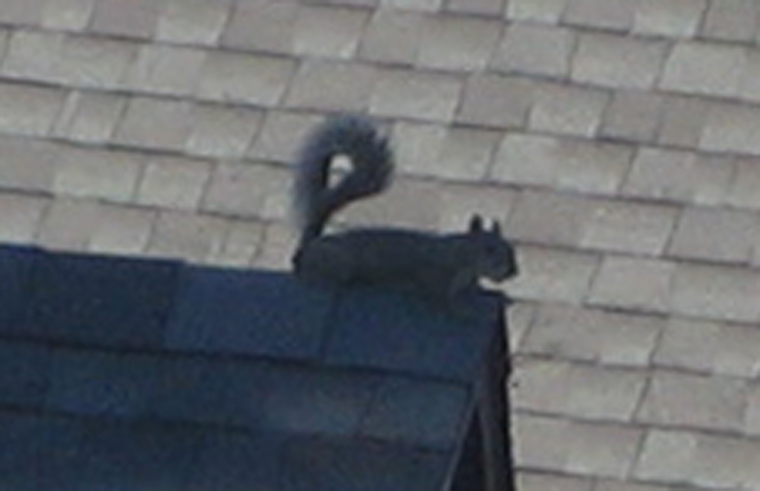- info@wildlife-removal.com
Call us for help in your town
Wildlife Removal Education
There’s a Squirrel on the Roof – What Do I Do?
Need squirrel removal in your hometown? We service over 500 USA locations! Click here to hire us in your town and check prices - updated for year 2020.
We have bad news for you, folks; if you see a squirrel on the roof, there’s a pretty good chance that the animal has already broken into your attic and could have even been living up there, quite happily, for many weeks or months now.

In almost all cases, squirrels on the roof will be looking to break into your attic, or have already done so and have built a nest up there. Why? Because the roof and attic of your building offer many of the same things that trees offer squirrels, out in the wild. There is protection up there, safety, shelter, and even food, and these things can all be found inside your attic too, once the critter has managed to smash its way in.
The first thing you should do when you see a squirrel on the roof, is go right up there after it and take a good look around. Clearly, you will need to take your own safety in to account when planning this, and we always recommend having a second person nearby to watch the ladder and make sure you can’t comer to any harm. We advise checking out the roof and attic from both the inside and the outside of the building, checking to see any little patches of damage or holes that could have been used as a potential entry point. These entry points are what you will need to seal up later on, but you can’t do that part until you are sure that all squirrels and other wild animals have been safely and successfully evicted from the building. Otherwise, you’ll just be shutting them inside and that will more than likely result in the animals’ death.
You will need to keep your eyes peeled for physical signs of the animal – feces, urine, nesting or bedding areas. Any waste or damage will need to be repaired and cleaned away, and if this is biological matter, you will need to clean the debris away safely, using high-strength antibacterial cleaners.
Any signs that you do see will help you, although, you might groan when you first spot them. It’s never a very pleasant experience to find droppings that some wild animal has left for you to clear away. The more signs you see, the more the animal or animals have been hanging out in that area. The closer you are to them, and the more you know about where they like to eat, play, and sleep, the better chances you will have of getting rid of them quickly.
Knowledge and understanding are two things you must have for this job.
Once all entry points have been figured out, you can use your removal method of choice. If you have a mother with young in a nest (likely), you will need to remove all of the family together if you want them to survive back out in the wild. Youngsters that are left behind will die without their family support network, especially if they are not yet old enough to find food for themselves.
Exclusion devices are really handy devices for when you have adult squirrels, just one squirrel, or for when the young animals are old enough to leave the nest. These can be attached to one or two of the main entry points, the rest of them sealed up. Eventually, all of the animals within the attic will need to leave to find food and other things, and once they do, they will be unable to get back into the property again, leaving you free to remove the exclusion devices and seal up the remaining holes. Again, you will need to make doubly sure that all animals have been carefully evicted before you start the sealing process.
Squirrels on the roof might be a sign that you have an animal about to break in, although, the chances of this being the case are rare. Either way, you should take a look at what led the animal up there. Are there branches that work as bridges right to the bits of your building you’d rather the animal couldn’t get to? Trimming back branches and twigs are a great way to avoid that from happening in the first place. If you have lots of food in your yard, you will need to remove that too. Anything that causes the squirrel to come and take a closer look is going to do just that, so by removing bird feeders, or making them more difficult to access for squirrels, as well as taking away any other sources of food that the squirrel might have (or has already) prey on.
There are so many modifications that you could make to your yard to ensure that squirrels are kept at bay, although, no critter-removal method is one hundred percent foolproof. Unless you have a garden or back yard that is entirely closed in with four walls and a roof, there will always be a way for animals to get in. Even buildings with four walls and a roof aren’t safe. If you make sure that your home is impenetrable, however, the squirrels can hang around all they like; they still won’t be able to get access to your humble abode.
Go back to the Squirrel Removal page, or learn tips to do it yourself with my How to Get Rid of Squirrels guide.


















